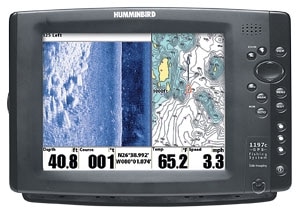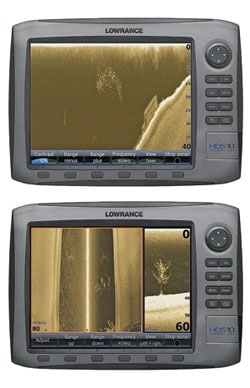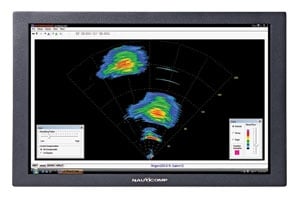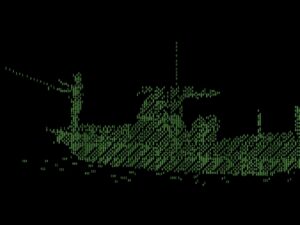
Side-scanning sonar is a mainstay in the tournament crowd, with top-of-the-line tools like the Furuno CH-270, gear which will have you stroking a check for $14,000 even before you punch a hole through your hull to install it. There is a place for this level of sophistication. Says Steve Bradburn, assistant product manager for Furuno, “With the fact that there are so many big tournaments out there, and one fish can be worth a million bucks, an expensive sonar makes sense. If you don’t have it and others do, you are at an extreme disadvantage.”
But an awful lot of fishing gets done for less than a million-dollar paycheck. For the rest of us, side-scanning sonar is earning its place on the console when the stakes are not nearly so high but a successful day is on the line.
South Florida angler and TV host of Sportsman’s Adventures, Capt. Rick Murphy uses side-scanning sonar as much as anyone in salt water, and the applications he has found provide a good overview of the way this technology can solve angling puzzles. He currently relies on Humminbird’s 11-inch display, model 1197c SI Combo ($2,609.99).
“I use it in the Everglades, where we have a lot of undercut banks and the water is the color of coffee with cream,” says Murphy. “I am able to look back under the undercuts from the surface to the bottom. The neatest feature of the unit is that, when I find something I want to remember, I run the cursor over it, push ‘mark’ and, instead of thinking later, ‘It was somewhere around here I saw that rock structure,’ I now have a GPS waypoint saved forever.”
One of the more profitable uses he has developed: “When we fish redfish tournaments in the Florida Panhandle, it is a dock fishery,” he says. “We can move along and see fish right up under the docks with the side-scanner.”
Side-scanning also comes into play in the Bahamas, says Murphy, where he uses it in combination with the color fish finder to

assemble a detailed picture of reefs and coral heads. “It allows me to really see the structure and how it lies, and lets me see the fish in and around it,” he says.
Other manufacturers are addressing the increasing usefulness of side-scan sonar with products and improvements targeted for specific fishing situations. For instance, there’s Lowrance’s LSS-1 StructureScan sonar ($599), a networkable module for the company’s HDS series. It’s targeted for anyone who’s fishing in up to 300 feet of water.
Unique to StructureScan is the dual view, which provides a picture to the side and a view straight down at the exceptional resolution afforded by high-frequency output and the enhanced Lowrance signal processing. Beam angle ranges from 30 to 50 degrees at 800 kHz and 35 to 70 degrees at 455 kHz, which is a pretty wide view. In many cases, the image created looks very much like a photograph. And the dual view quickly orients anglers for easier interpretation of the initially counterintuitive side-view image.
“The real nice thing about having the down-scan is you get a traditional-looking sonar picture with extremely high detailing,” says Luke Steward, product manager for Lowrance, “so you know where the objects are. And a tree looks just like a tree; you can see all the branches. You can see fish and pick out targets. If you are sitting still and a fish swims under you, it looks like a fish. You can actually see fish on the screen. We have images of tarpon taken from the screen, and you can see the fins.”
Interphase Technologies, a longtime player in the side-scanning arena, has announced a major upgrade to its products with the Multibeam Forward-Looking Sonar. The Multibeam boasts a speed-of-sound update rate, says company president Charles Hicks. The prior version sent a single ping, while this one collects information across the entire range (either 90 or 180 degrees, depending on the configuration) of the sonar scan and digitally creates an image from all the beams at the same, so, effectively, it updates 24 times a second. “The picture looks live, like a little movie,” says Hicks.
Fishing applications where the Multibeam excels range from locating bait to tracking individual fish. “When most people fish, they only look down with sonar, so they have to stumble on the bait schools. In Monterey

Bay, California, with this sonar, we have been seeing schools of sardines several hundred feet out in front of the boat,” says Hicks. The continuous refresh allows tracking of individual fish as well. “Some people are looking for albacore with the Multibeam, and it’s also good for marlin or any reasonably large fish,” says Hicks. “What’s great about this is it is fast enough to track the target. With sonars in the past, you might see a fish, and the next time it refreshes the fish has moved on. This one is so fast you see the fish moving.”
The Ultrascan PC-90 version of the Multibeam starts at just under $4,000. All new models are fully compatible with existing Interphase transducers and installations, allowing easy upgrades.









